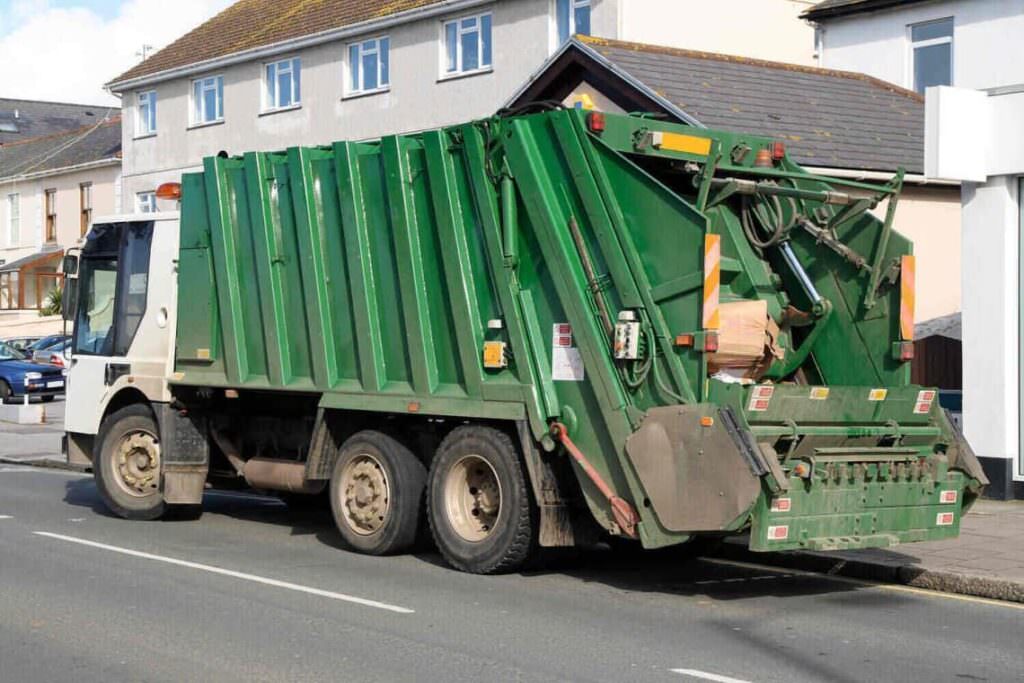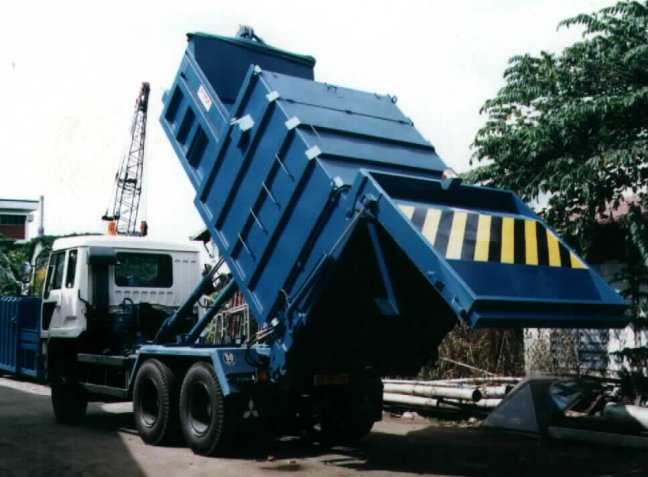
Earlier this year, the Singapore news was flooded with a story of a woman who narrowly escaped being struck by a garbage truck. A quick online search shows that garbage truck accidents are not as uncommon as one might expect.
That said, it’s evident that garbage truck drivers need to exercise an enormous amount of caution when operating their vehicles. Additionally, due care needs to be taken to ensure that all safety measures and procedures are followed.
At Syntech, we take a more extensive look at the following:
- Understanding the garbage truck
- Operating the garbage truck safely
- Pre-operation checklist
- Safe ways to dump the load
- Dealing with potential hazards
Understanding the Garbage Truck

Before a garbage truck driver or assistant starts working on a waste disposal truck, it’s essential to understand exactly how one works. Here’s a breakdown of the basics all waste management crews need to know to avoid any accidents involving any components of these monster trucks.
- Hopper: This refers to the back “bucket” area where garbage collectors place rubbish into.
- Compacting mechanism: Garbage is moved from the hopper by the compacting mechanism and then placed into the truck’s body.
- Hydraulic cylinders: Several hydraulic cylinders keep the garbage inside the truck to prevent it from falling out.
- Compacting device: Compacts the garbage to allow as much rubbish to be placed inside as possible. To enhance the available space, this device is often placed on the outside of the truck.
For a more detailed look at the different types of garbage trucks as well as how they operate, we recommend reading our article, “What is a Garbage Truck & How do They Work?” to see some helpful information.
To procure your own garbage truck for your enterprise, click on the link below.
ENQUIRE WITH SYNTECH ON PROCURING YOUR OWN GARBAGE TRUCK
Operating the Garbage Truck Safely
There are many facets to operating a garbage truck safely. Garbage truck companies have implemented a series of checks and balances to minimise truck accidents and serious injuries. These are discussed below.
Pre-Operation Checklist
Waste removal vehicles can be dangerous to operate and with so many moving components, personal injury is always a risk. Additionally, since these vehicles operate up and down our busy roads, accidents with commercial vehicles are also not impossible.
Many garbage truck accident attorneys will agree that faulty components can easily be to blame for many injuries sustained. That said, the truck driver must ensure that a pre-operation checklist is performed before setting out on each route. The most basic of these checks are summarised below.
| Component to Check | What to Check For |
|---|---|
| Hydraulics and lift mechanism | - Check that lifting equipment is functioning correctly - Ensure that hydraulic fluid levels are sufficient and flowing without being clogged by dirt - Ensure the hydraulic cylinder rod isn’t worn |
| Tires and wheels | Truck drivers must check tires for proper pounds per square inch (PSI) and tire tread depth |
| Lift arms for side-loaders (Side-loader waste removal trucks use lift arms and these are subject to wear and tear) | Ensure that pin retaining bolts are tight and not broken or worn. Check the lift bolts, mounting bolts and lift controls |
| Oil levels and fluids | Check the air dryer and valves for proper oil levels. Ensure that other fluid levels are sufficient such as engine oil and coolant. |
| Brakes, lights, signals | All brakes, lights and signals must be checked and tests. |
| Mirror and camera | All mirrors and backup cameras must be checked for damages and must be tested to ensure that there are no blind spots. |
| Emergency equipment | Emergency equipment on and inside the truck must be checked and tested. This includes emergency triangles, fire extinguishers and even jumper cables. |
| Last service date | Drivers need to make a note of future service dates to avoid penalties due to outstanding service. |
Driving Safely
Once the truck driver has confirmed that the pre-inspection checklist is done, the next aspect of avoiding garbage truck accidents involves driving safely. Here is a list of the most basic tips to keep in mind when you’re setting out on your route:
- Obey all legislated traffic laws of the area you’re driving in—drivers may need to brush up on local traffic rules if they’re working out of their usual areas.
- Maintain a safe speed and following distance between other vehicles.
- Check blind spots before turning or changing lanes.
- Use turn signals and hazard lights to advise other motorists of the truck’s intention to turn or stop for a load.
- Watch out for pedestrians, cyclists, and other instances that may cause distracted driving.
- Drive slowly in areas of poor visibility, severe weather, and excess traffic.
Operating the Lift Mechanism
Another instance that could result in a personal injury claim stems from incorrect or negligent use of the lift mechanism. To avoid this, truck drivers must enforce the following steps for operating a lift mechanism safely:
- Position the garbage truck correctly.
- Use the lift controls EXACTLY as specified for that particular model.
- Familiarise your crew with the area to avoid overhead obstacles.
- Check the area to ensure that there aren’t people around who may sustain a personal injury in case of lift failure or any other vehicle malfunction.
Dumping the Load
The next step in preventing a garbage truck accident involves taking caution when dumping the load. Consider the following tips:
- Once at the location where the garbage must be dumped, be sure to position the truck correctly and safely.
- Be aware of overhead or surrounding obstacles.
- Secure the load before dumping,
- Ensure that mechanisms are operated correctly and in sequence.
- Check for people or objects around the truck before engaging the release mechanisms.
Dealing with Hazards
The sheer size of even the smallest garbage truck puts it at risk of creating a serious accident. This is especially the case when these trucks move around on busy roads and sometimes experience limited visibility.
Working on tight schedules may also be a contributing factor when drivers are rushing to complete jobs. Some hazards to keep an eye out for include the following:
- Overhead obstacles such as low-hanging trees and cables.
- Pedestrians and cyclists moving around on your route—especially if the route is during peak or heavy traffic times.
- Other vehicles.
- Uneven or unstable ground.
- Road construction may make maneuvering on the street difficult.
Tips for Avoiding Hazards and Responding to Them if They Occur
If you’re new to driving a garbage truck in the streets of Singapore, then these common tips for avoiding hazards are worth memorising!
- Familiarise yourself and your crew with the activities in the area around the time you will be working in it. This may involve visiting the site beforehand.
- In instances where there are road works, it may be a good idea to check for an alternative route.
- If the ground where you need to stop to collect or dump garbage in uneven or obstructed, look for an alternative stopping point rather than risking a serious accident.
- Keep in mind that the driver and the company in question could be kept liable for the medical expenses of any injuries sustained if safety rules aren’t adhered to.
- When drawing up your schedule, keep in mind that city streets may be more congested than the average residential neighborhoods—you may have to factor in additional travel time.
- Always obey the rules of the road and reduce driving speed in instances of limited visibility.
- Ensure that all crew members working on the garbage truck are familiar with the safety rules, what to do in an emergency as well as how the truck and various mechanisms operate.
Work with Syntech on your Garbage Trucks
Avoiding garbage truck accidents is an essential part of every garbage truck driver’s daily function. Using the tips and suggestions in this article will go a long way toward avoiding serious accidents and any types of bodily injuries.
Furthermore, if you’re looking for a company to design or custom fit your garbage truck, look no further than Syntech.
ENQUIRE WITH SYNTECH ON PROCURING YOUR OWN GARBAGE TRUCK
If you have found the safety tips and suggestions shared in this post helpful, be sure to share it with colleagues or friends and family working in the trucking or more specifically, garbage truck business. That way, everyone operating garbage trucks can help keep our society safer!
